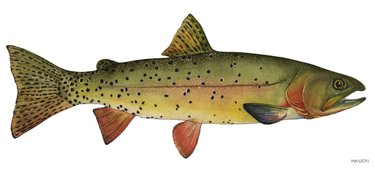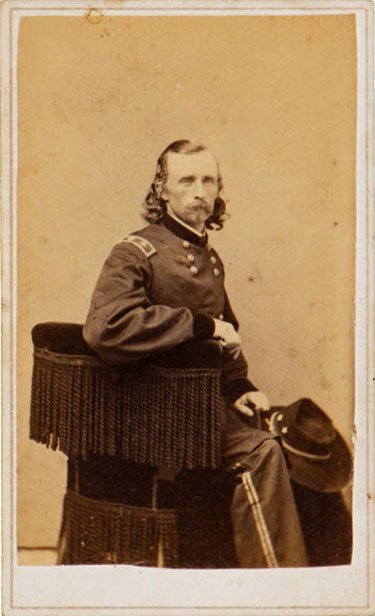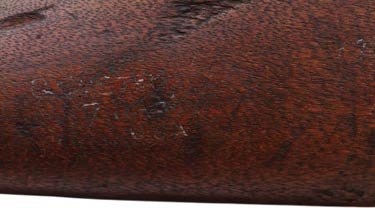Category Archive 'George Armstrong Custer'
13 Jun 2021

On 13 September 1877, Captain Frederick Benteen led a company of the 7th Cavalry into the Battle of Canyon Creek armed… with a fly rod! Richard Lessner at the Museum of American Fly Fishing blog explains the key role of Salmo clarkii in George Armstrong Custer’s disastrous defeat one year previously at the Little Big Horn.
16 Aug 2018


H.W. Crocker III has written an alternative history novel in which George Armstrong Custer survives the Battle of the Little Bighorn and becomes a Western gunslinger, which demonstrates that he has some expert knowledge of the man’s political opinions, and he offers, in voice of the Alt-Right, American Greatness, eleven reasons why, if he were here and alive today, General Custer would be wearing a MAGA hat.
He liked hats, and though he was proud of his golden hair, it was thinning a bit. A hat could come in handy.
2. Red looked good on him—an essential part of his self-styled uniform in the Civil War was a red cravat. He didn’t care that such flash made him an easy target for snipers. Cutting a figure for the men was more important. And he wouldn’t have been intimidated from wearing a MAGA hat while walking the mean streets of Monroe, Michigan.
3. Custer was a conservative Democrat who would have been a prototypical Reagan Democrat and Trump Democrat, driven by deep-rooted patriotism.
He could be right. Custer was a Northern democrat, and had he survived the battle and returned east victorious as a national hero, he was angling for the Democratic Party’s nomination and could very possibly have won the nomination instead of Tilden.
Whether he could have done as well as Tilden did in the South, and decisively defeated Hayes, well, that is less clear. During the War, Custer was a brutal adversary, prone to insult his opponents, and there were good reasons for a Southern animus against him.
Would Custer have defended Confederate monuments, as Crocker claims? I’m less sure.
RTWT
25 May 2018


George Armstrong Custer, Carte de Visite by Goldin. Taken in May 1865, just after the conclusion of the war. Custer was in Washington for the Grand Review celebration.
Tom Slater, in the latest Heritage email, introduces the upcoming June 9th GEORGE ARMSTRONG CUSTER AND THE PLAINS INDIAN WARS Auction at Heritage Auctions:
For Garryowen And Glory!
Those were the prophetic closing words of the regimental song of George Armstrong Custer’s 7th Cavalry. As a boy growing up in the days of black-and-white TV my favorite “old movie” was They Died with their Boots On, starring the incomparable swashbuckler Errol Flynn as G. A. C. I watched it countless times. Who could forget the catchy tune played over and over during the film, or the image of Custer, the last man standing, blazing away, six-gun in each hand, as he was ridden down by a horde of Indians? Eventually I would have to unlearn most of the contrived “history” related in the movie, but my disillusionment did little to discourage my fascination with the saga of Little Bighorn and Custer’s Last Stand.
Barely 200 men perished with Custer, a seemingly insignificant number when compared to the tens of thousands of casualties in other American battles. Why does the Little Bighorn saga still hold such fascination nearly a century and a half later? Undoubtedly, part of the allure lies in the fact that Custer was a genuine American hero long before the events of 1876. The youngest man to be made general during the Civil War, he was famous for his exploits as a cavalry commander — as well as for his golden locks and flamboyant dress. After finishing dead last in his West Point class, Custer certainly made his mark. During the decade before Little Bighorn he led the 7th Cavalry as they fought Indians and explored new territory with the Yellowstone and Black Hills Expeditions. By the time of the disastrous battle in 1876 he was a celebrity and a household name.
Further adding to the drama was the possibility that personality traits and conflicts played a role. Was Custer brash and irresponsible in rushing to attack the large Indian encampment, or was he simply acting on what he thought was reliable military intelligence? Was the failure of Capt. Frederick Benteen to come to Custer’s aid a sound military decision, or was he influenced by his well-known personal distaste for his commander? Was Major Reno’s retreat after initially assaulting the village an example of cowardice, or an unavoidable response in the face of unanticipated, overwhelming resistance?
Lastly, there was the epic significance of a number of Plains tribes and bands coming together for one last, great celebration of their vanishing way of life, and to make a final valiant stand against the inevitable encroachment of “civilization.” It is now known that the Indian camp was aware of the soldiers’ approach, but failed to scatter as had been their tactic in the past. Rather they waited almost passively for the great confrontation, knowing full well that, even if they managed to win the battle, they had already lost the war.
It is our great honor to bring to you on June 9th an amazing auction focused on those historic events and the personalities associated with them, titled “George Armstrong Custer and the Plains Indian Wars.” We are especially gratified to present the important artifacts and relics amassed by Glenwood J. Swanson, the highly respected Custer collector and scholar whose items make up a large portion of the auction. Glen is particularly appreciated for his ongoing support of archeological endeavors at the Custer Battlefield and for his landmark book, G. A. Custer His Life and Times, published in 2004. Lavishly illustrated, largely with items from his own collection, this book gives wonderful insights into Little Bighorn and the men who fought there.
29 Aug 2016


George Armstrong Custer with his original staghounds, Blucher and Maida. The Indian Scout Bloody Knife is at Custer’s righthand side.
Between 1867 and 1875, George Armstrong Custer contributed fifteen letters, published under pseudonym “Nomad”, to the New York-based sportsman’s journal Turf, Field and Farm. His letter indicate that Custer spent most of time, when not fighting Indians, hunting big game on the Western plains accompanied by a couple of Scottish staghounds.
Dutch Salmon reports finding a letter in an old issue of Forest & Stream that contends that Captain Miles Keogh‘s horse Comanche may not have really been the sole four-footed survivor of five companies of the 7th Cavalry’s Last Stand, 25 June 1876.
Most accounts have it that when Custer and the Seventh Cavalry rode to their doom at the Little Bighorn, his hounds were left behind in camp. However, in a 1907 letter to the old Forest and Stream magazine, a reader wrote that he had seen one of Custer’s hounds—â€one of the pair that came from Queen Victoriaâ€â€”at Ft. Washakie in September, 1882. The correspondent added:
“Three days after the fight, when a scouting party reached the battle ground where Custer and the few survivors had made their last stand, the greyhound was found lying down near his dead master. A rifle bullet had struck him near the eye which made him blind on that side, but otherwise he was uninjured. He was taken good care of by the party and finally found a master in Lieut. R.E. Thompson, of the Sixth Infantry, who was stationed at Washakie when I was there. It was the lieutenant himself who gave me the above details concerning the dog.â€
Was the dog truly a greyhound? Or was it one of the staghounds, a greyhound in rough coat?
06 Dec 2012


George Armstrong Custer’s Personal Army-Issue Model 1865 Spencer Carbine
A good friend from Yale, Tom Slater (JE ’72), is Director of Americana at Heritage Auctions in Dallas. An email update from that auction house reports that Tom has outdone himself in putting together a really spectacular group of offerings for Heritage’s December 11th & 12th Western Americana auction
The undoubted highlight of the sale is George Armstrong Custer’s personal Spencer repeating carbine, bearing his name scratched on the buttstock, and frequently mentioned in his accounts of hunting. The bidding starts at $50,000; but, even with recession clouds still lowering over Obamistan, it will probably go much higher.
[T]he Spencer carbine offered here pre-dates his Fort Abraham Lincoln period, it does date from the Indian Wars, and could quite possibly have been with him at the Battle of Washita.
It was part of the legendary collection of Dr. Lawrence A. Frost of Monroe, Michigan, who at one time had what may have been the most extensive private collection of Custer artifacts and relics ever assembled. A signed identification tag in Frost’s hand which accompanies the gun identifies it as a “Spencer Carbine – Saddle Ring / Cal. 50, No. 3658, Model 1865 / ‘G. Custer – 7 Cav USA’ cut into wooden stock…Used by Gen. Custer in Kansas in 1867 campaign.” …
Dr. Frost purchased the carbine in 1955 from Howard Berry. A notarized bill of sale describes the gun in detail. In a 1973 letter (a copy of which is included in this lot), Frost refers to purchasing various Custer items from Berry, whom he describes as “a former 7th Cavalryman”. Frost states that he showed them to James Calhoun Custer (a nephew of Gen. Custer and son of Nevin Custer), and that Custer assured him he remembered these items which had been shown to him by his father who stated that they were the General’s.
Custer used a wide range of military and commercially available firearms over the course of his career, but he had a special familiarity with Spencer carbines. During the Civil War his Michigan regiments were armed with Spencers (Carbines of the U.S. Cavalry, John McAulay, p. 32). As the war ended, a new Spencer model was issued to the army with a more powerful 56-50 cartridge (Spencer Repeating Firearms, Roy Marcot, pp. 80-81). When the 7th Cavalry was formed in 1866 (Bugles, Banners and War Bonnets, Ernest Reedstrom, pp. 1-2), the Spencer Carbine became standard issue (Carbines of the U.S. Cavalry, p. 88), and was in use by them until replaced by the Sharps carbine in 1870 (Carbines of the U.S. Cavalry, p. 95). In his 1980 book, Nomad, George A. Custer in Turf, Field and Farm, Brian W. Dippie reproduces an 1867 article written by Custer in which he describes in great detail a buffalo hunting expedition. He describes learning that pistol shots “only seemed to increase (the buffalo’s) speed.” Accordingly, Custer wrote, “I concluded to discard the use of my revolvers and trust my Spencer carbine” (p.117). The example offered here, serial #3658, is the 1865 model and should not be confused with the Spencer rifle gifted to Custer in 1866; that gun has never surfaced (Spencer Repeating Firearms, p. 152). The presentation gun would have been the 56-44 sporting model.
Custer’s regard for his Spencer carbine is evidenced in his own words in his autobiography, My Life on the Plains, where he writes: “Leaping from my bed I grasped my trusty Spencer which was always at my side” (p. 77).

“G. Custer — 7 CAV, USA” cut into buttstock.
Your are browsing
the Archives of Never Yet Melted in the 'George Armstrong Custer' Category.

Feeds
|










